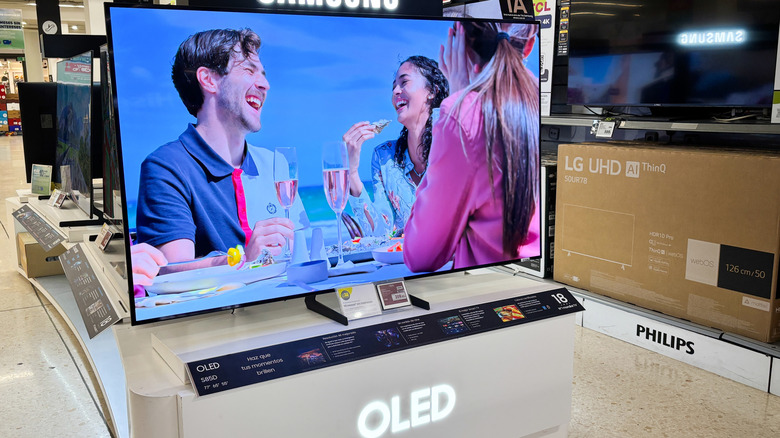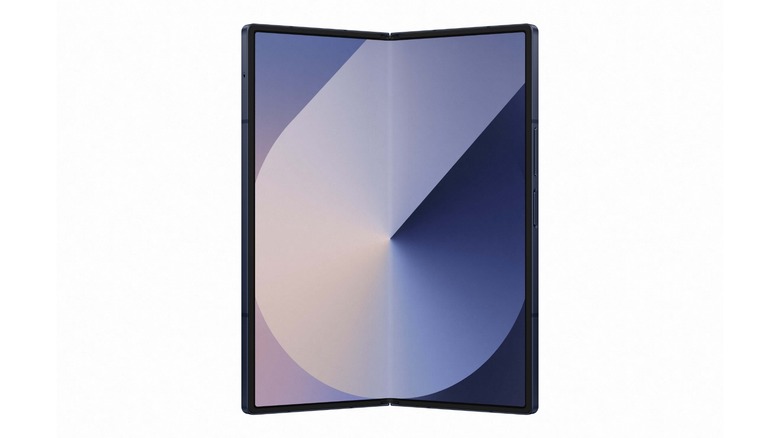What Does OLED Mean? (And Why It's Such A Great Choice For TVs)
We may receive a commission on purchases made from links.
Spend some time browsing for televisions, computer monitors, or even mobile devices, and you're likely to get hit with a barrage of all-caps acronyms. IPS, LCD, and more, it's enough to glaze over the eyes of even the most dedicated shopper, especially when the differences often seem abstract. But one term continuously crops up in the context of premium displays: OLED. It's the holy grail of display technology for many, thanks to its uniquely advanced capabilities that allow it to produce some of the richest and most accurate pictures on the market. But what does it stand for, and what makes it so incredible on devices from iPhones to premium TVs?
OLED stands for Organic Light Emitting Diode, and displays that utilize this technology represent a massive leap forward over the older LCD (liquid crystal display), which is characteristic of most flat-screen displays. Whereas those displays work by illuminating an array of pixels using a backlight, OLED panels contain self-illuminating pixels made of an emissive material sandwiched among transport layers, as well as anode and cathode layers that create an electric current much like a battery. Technical gibberish aside, this results in a display that can illuminate each pixel individually.
The benefits of this approach compound with one another, leading to a superior picture when an OLED is compared to an LCD of similar quality. You're likely to see OLED in a wide range of products these days, and the inclusion of an OLED screen on a phone, laptop, or TV is likely to indicate that it's a more premium product.
OLED, or Organic Light Emitting Diode displays make for excellent TVs
Head to your local electronics shop, scan the TV shelves, and you're likely to see that OLED TVs are generally more expensive than LCD-style televisions like QLED. Not only are OLEDs more expensive to produce, but they create better pictures, too. Their ability to individually illuminate pixels means that when there's black in an image, those pixels simply remain turned off. They're pitch black, with no illumination at all, even for a backlight. Because of this, OLED displays have infinite contrast — the perceived difference between the brightest and darkest part of an image that adds to its richness, while also being more energy efficient.
The biggest drawback of an OLED is usually that it can't get quite as bright as an LCD. That's because each pixel illuminates itself rather than relying on a massive backlight shining through the whole array. However, this problem is much less noticeable on a TV than it is on a mobile device, and it's well worth the improvement to contrast and color OLED brings to the table. With that said, many consumers won't opt for OLED TVs due to their price. On our recent roundup of great value TVs for their prices, only a single OLED made the cut. That would be the LG OLED B4 55-inch, which is one of only a handful of large OLED TVs to fall below the $1,000 price point.
OLED displays are also fantastic for mobile devices
OLED displays not only have generally better battery life and superior images on smartphones and tablets, but they have also led to futuristic innovations like foldable phones. Samsung, one of the world's largest display manufacturers, pioneered foldable screens using a type of OLED called AMOLED (Active Matrix Organic Light Emitting Diode). These displays arrange their emissive layers into a sub-pixel array, where each pixel has a red, blue, and green color inside that can be combined to create any color. Since these displays can be extremely thin and don't need a uniform backlight, they can be folded without breaking. Samsung first experimented with curved displays on the Galaxy Note Edge, released in 2014, and then made curved displays mainstream for nearly a decade before phasing them out. In 2019, the company made its biggest leap forward in OLED experimentation by releasing the Galaxy Z Fold. It was the first mass-market foldable phone, and the 7th generation is set to arrive this summer.
Apple innovated on OLED with the 2024 M4 iPad Pro by introducing what it calls Ultra Retina XDR, also known as tandem OLED. Essentially, these screens have two OLED panels layered on top of one another. While this might seem odd, it fixes one of the biggest issues with OLED, which is that they can't get as bright as LCDs since each pixel is working alone. With two stacked OLEDs, things get a lot brighter. Apple partnered with Samsung and LG to make these displays possible, and was the first company to use tandem OLED in a tablet form factor.
Who knows what further innovations are possible as the industry continues to push the boundaries of OLED technology. Whatever the future holds for this tech, it's sure to be bright.


